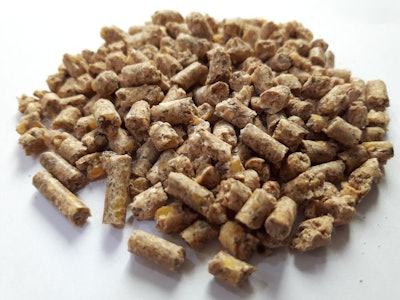
Although more expensive, pellets have certain benefits appreciated by growers
Pelleting is expensive. It not only requires investment in expensive machinery, but operational and (professional) labor costs are significant. But, while this is true, broiler producers prefer pellets over meal feeds.
Here, we will examine the reasons that make pellet feeding a preferable option for broilers. Before that, and in contrast with pigs, it should be noted that broilers prefer a rather small(er) pellet size, and definitely a much more durable pellet as they do not have to chew it. This has certain implications in feed formulation and pellet processing, but experienced nutritionists and pelleting operators are already aware of these issues. We need only to remind ourselves why it pays to feed such pellets to broilers.
Meal is sticky
In wheat-based diets, feed – when mixed with saliva and water – will often become sticky due to the high wheat gluten presence (the pasty dough effect). And as broilers often interchange between eating and drinking, this problem only gets worse with time. Sticky feed will become caked on the surface of their beaks, something that decreases their welfare, and reduces feed intake, not to mention the possibility of harboring pathogenic bacteria.
Similar problems can be observed with oats, triticale and rye. One solution is to feed such cereals in coarsely ground meal form, but unless rolled, hammer milling (the most usual and less expensive grinding method) will always produce a number of fine particles. The problem of sticky feed is not mentioned often in diets based on corn or sorghum, or with mixed-cereal formulations that contain a significant amount of these two cereals.
Pellets are more digestible
Pelleting involves heat at two points. First, during mass conditioning, steam is injected for a variable period of time. Second, during pressing through the pelleting die, pressure friction increases heat on the surface of the pellet. During both times, heat cooks nutrients, and neutralizes some anti-nutritional factors, and even some pathogens.
It is well known that cooking (thermal processing) increases digestibility (at least for the young) of nutrients, or increases the absorption rate. In either case, animals receive more nutrients and/or consume more feed.
Overcooking, however, has the exact opposite results and for that the right pelleting conditions should be matched with each formulation design.
Pellets can help in antibiotic-free programs
As mentioned above, heating destroys pathogens, given enough exposure to high temperatures. However, this does not mean pellets will arrive at the bird’s feeder pathogen-free, as there are numerous opportunities to be recontaminated along the way, but it is a good start.
In some cases, exposing feed in super high temperatures for a fraction of the time ensures pathogen elimination without destroying the nutritive value of the feed, but this is another specialized manufacturing application. The combination of pelleting and coarsely ground cereals (albeit difficult but not impossible to make a strong pellet) is the best combination to benefit from both worlds in terms of gut health.
Birds eat more with pellets
Meal is not the natural feed of birds. Birds are pickers, and it is more natural for them to pick up a pellet than a scoop of meal feed. Thus, birds consume pellets easier and faster, meaning they can consume more at any given period of time.
Meal feed tends to absorb water fast once ingested and this causes quick satiation. Instead, pellets, and particularly hard ones, take longer to be imbued with water and thus birds will continue to consume feed for a bit longer. That extra amount of feed, combined with the higher digestibility of the feed, will increase overall ingestion of nutrients in an animal as appetite insatiable as the modern broiler.
Pellets reduce air dust
Air quality in any broiler facility is one of the most important criteria of animal welfare as it can lead to significant health problems. Thus, eliminating one more cause of diminished air quality can be significant.
Meal feed contains many minute particles that are easy to escape the feed when delivered or eaten by the birds. Meal feed always increases dust in the air, but it also makes building cleaning rather difficult, due to caking on surfaces when combined with moisture.
Moist caked feed on surfaces is another ideal substrate for pathogen proliferation. Coarse feeds reduce this problem but only to a certain degree as mentioned already above due to the nature of hammer-milling process.
Pellets avoid feed separation
Not all ingredients have the same specific density (weight per volume). Thus, a piece of limestone is much heavier than the same-sized corn particle. In this case, limestone will sink at the bottom of the feeder, while corn will float at the top.
Plus, birds being pickers, will pick those particles – especially if coarsely ground – that interest them the most. So, they are unlikely to gather the often bitter or tasteless (at best) dust gathering at the bottom of the feeders. This creates a huge nutrient imbalance in their nutrition, leading to significant decrease in flock growth uniformity. Instead, a pelleted feed ensures that each pellet contains a more complete profile of all nutrients required for uniform growth.















